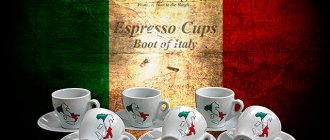White cup of coffee with beans The spread of coffee throughout Europe occurred through two different channels, one associated with international trade and the other with war.
Read about how the Arab world became the discoverer of coffee, about the history and homeland of coffee in the article on our website.
How did coffee enter Europe?
Drawing on their strong trade contacts throughout the East, Venetian merchants began importing coffee beans along with shipments of spices, silks, and perfumes.
Initially, coffee was sold at pharmacy prices in pharmacies as a medicine for the digestive tract. Local wine merchants soon felt threatened by the growing popularity of coffee among the students and faculty of the University of Padua, then an important intellectual center in the Venetian mainland. Additionally, coffee was met with zealous denial among parishioners in Catholic city-states. Seeing that it came from Arab countries, the priests called it “the drink of Satan” and insisted that it had nothing to do with Christian life.
Thanks to brisk trade, Venetian merchants began offering coffee to wealthy people in Venice in 1615, charging them high prices for the drinks. Thus, coffee was introduced to the European continent.
By 1650, coffee had become popular in Europe, leading to the emergence of coffee shops and cafes.
Espresso with whipped cream
Bankruptcy of the original business
The founder saw the promising development of his idea and planned to open at least 50 more establishments. However, in the fall of 2021, Ivan Kvasov announced the closure of all Stories coffee shop chains. Many authoritative publications, such as RBC, reported the reason for a debt of 30 million rubles.
The entrepreneur himself commented on the news in this way: “The network is stopping its activities due to a gradual decline in public interest, high costs, lack of funding and other reasons.”
The first coffee shop in the world
The world's first cafe opened, according to some sources, in 1554, according to other sources, in 1475 in Constantinople.
The very first “bottega del caffe” was opened in 1640 in Venice thanks to the thriving port activity.
Because of its Eastern roots, coffee in Italy was from the very beginning considered sinful and an Islamic threat to Christianity. However, its popularity grew regardless, and Pope Clement VIII, having tried the pagan drink, was immediately fascinated by the unique taste and aroma.
Since the mid-17th century, coffee has been sold in Italy by mobile vendors who also offer hot chocolate, lemonade and liqueurs from their stalls.
Cafe in Italy
Where did the first coffee shops appear and when?
Since coffee originates from the Arab world, coffee shops began to appear in these countries. The first two establishments opened in Constantinople, now the modern capital of Turkey - Istanbul, in 1554. The popularization of the consumption of an invigorating drink in gastronomic establishments pushed society to begin opening them in various European countries. The first coffee shop in Italy opened its doors to visitors in the mid-17th century. Since coffee came to the eastern part of Europe thanks to sea transportation, the first coffee shop was opened in Venice in 1654. Well, the Florian coffee house is especially popular, which has been welcoming its visitors from 1720 to the present period.
After conquering the European market, coffee began to spread to the northern part of the globe. On the English island, a coffee and gastronomic establishment was opened in 1652. However, in this state they were characterized by a distinctive feature. Here the coffee shops were called “one-penny universities” because they charged both for a cup of invigorating drink and for entry into its premises.
Since England owned lands on the American continent, its leaders brought their culture to America. Thus, in 1670, the first coffee shop was opened in the capital of Massachusetts, Boston, by William Penn. The country of eternal fashion, culture and style - France - was not long in coming. This is where a coffee shop first appeared in Paris in 1672 thanks to a native of Sicily, Francesco Proccopio. The merchant made a tactical move and opened an establishment opposite the popular Comedie Francaise theater. The highest elite had the opportunity to organize their meetings in modern establishments over a cup of aromatic drink of vigor.
In central Europe, the first gastronomic coffee establishment opened in 1683 in Vienna, after the liberation of the country from the invaders of the Ottoman Empire. Yuri Franz Kulchitsky developed his own recipe for making the drink. Now there are over three thousand coffee establishments in the Austrian capital. Their distinctive feature is not only spending time together, but also the privacy of a person over a cup of coffee with a newspaper or his thoughts.
In the German capital Berlin, the first coffee shop began operating in 1721.
Origins of cultural coffee consumption
Then bottega del caffe, the prototype of a modern coffee shop, entered the scene. Although it is widely believed that the first Italian coffee shop was opened in 1645, the first reliable documents are given in 1683, when a coffee house opened in St. Mark's Square in Venice. Coffee houses spread so much that on October 4, 1759, Venice passed a law stating that their number could not exceed 206. However, by 1763 there were 218 coffee houses in Venice. Friends, lovers, aristocrats and merchants gathered in them. By buying a lady a cup of coffee and sending it to her table, you could express your love and devotion to her.
Bottega del caffe is an original coffee shop. Bottega in Italian means a small store or shop where a small business operates. Initially, coffee shops in Italy were called bottega del caffe'. Nowadays they are called bar, cafe or pasticceria. The bar offers a variety of coffee-based drinks, as well as pastries, light snacks and alcoholic drinks. The cafe may also serve light snacks. Pasticceria is where you get a wide variety of cakes and pastries in addition to all types of coffee and soft drinks.
The first bags of coffee were brought directly from Turkey by botanist and doctor Prospero Alpino, and in just a few years this exotic drink conquered the Venetians. At that time, it was considered a product only for the elite society, quite expensive and sold only in pharmacies.
According to the Italian Coffee Committee, there are now more than 800 coffee roasters and more than 150,000 espresso cafes in Italy. In 2021, Italians consumed 5.9 kg or 13 pounds of coffee per capita. For more complete information about coffee in Italy, read the article.
Italian traditional coffee bar
The first coffee shops
We know nothing about the earliest coffee drinkers, but we almost certainly know that they lived in Ethiopia. Mention of the drink "bansham" - and apparently this is coffee - is found in Arab historical documents dating back to 900-1000. In addition to the properties of this drink, beneficial for the stomach, limbs, skin, ancient authors Fr. Indeed, the aroma of coffee miraculously seems to be absorbed into the skin. One Arab legend (circa 1250) says that during his wanderings, Sheikh Omar saw a wild coffee tree. The hungry sheikh decided to boil some fruits and drank the resulting invigorating drink. He offered to drink it to the weak and sick, and they got better. Among the most famous legends associated with coffee is the story of a shepherd who kept goats somewhere in Arabia or Egypt. It was he who noticed that goats, after eating coffee fruits, became much more cheerful. He shared his observations with the abbot of the nearest monastery. He decided to test the properties of the plant on monks, and soon they stopped falling asleep during night prayers. Over the past 200 years, experts studying the origins of coffee have come to interesting conclusions. One researcher claims that coffee existed back in the time of Homer and that it was the same miraculous drink that Helen brought from Sparta to Troy. Another historian believes that King David received coffee from Abigail and that Esau and Ruth drank it. There are records that in 1454 the Mufti of Aden visited Ethiopia and saw his fellow countrymen drinking coffee there. Returning home, he ordered coffee fruits to be brought to him; a drink from them not only cured him of his weakness, but also gave him vigor. An infusion of coffee fruits quickly gained popularity among the dervishes. The use of coffee as a drink and its cultivation in Yemen undoubtedly began much earlier than 1454. However, this year the authorities officially recognized the tonic properties of coffee.
The first coffee shops appeared in Mecca. They were called "kava canes". From Mecca, the tradition of setting up coffee houses spread to Aden, Medina, Cairo. Coffee arrived in Constantinople in 1517, after Sultan Salim I entered Egypt. The tradition of drinking coffee began to spread throughout the region, and in 1530. took root in Damascus, and in 1532 - in Aleppo. In Damascus, the most famous establishments were the Rose Coffee House and the Coffee House at the Gate of Salvation. There were no coffee houses in Constantinople itself until 1554, but immediately after their appearance they became famous for the luxury of their furnishings, as the owners of the new business tried to beat their competitors. It was in coffee houses that meetings, both business and friendly, took place, and over time they became a place for discussion on sensitive political topics. In attempts to ban the sale and consumption of coffee, things went so far as to sew “hardcore coffee drinkers” into leather bags and throw them into the waters of the Bosphorus. Soon the state stopped the persecution and imposed a substantial tax on coffee.
EUROPEAN COFFEE SHOUSES
It is worth recalling why coffee shops have taken root so quickly in the Middle East and Europe. It’s just that before the advent of coffee shops, people had nowhere to enjoy the pleasant taste of a relatively inexpensive drink, and even in good company. Coffee finally settled in Europe in 1615. through the efforts of Venetian merchants. Coffee in popularity was slightly behind tea, which began to be sold in Europe in 1610, and noticeably inferior to cocoa, supplied by the Spaniards from the New World since 1528.
In Italy, clergy initially wanted to anathematize coffee, considering it a devilish drink. Pope Clement VII (1592-1605) decided to personally try coffee and was so pleased with its taste that he blessed it and called it “the drink of a true Christian.”
In Europe, coffee was initially considered a healing drink and was expensive. As far as we know, the first coffee shop (bottega del caffe) opened in Venice in 1683, but there are assumptions that it was in 1645. Cafe "Florian" on St. Mark's Square - one of the most famous and expensive in the world - opened in 1720. Florian Francescani. It was in Italy that coffee houses acquired the name “cafe” (caffe - in Italian, cafe - in other European languages).
Coffee houses began to open throughout Italy, but most of them were in Venice. Giorgio Quadri, the “discoverer” of Turkish coffee, founded his establishment in 1775. Then “Duc de Toscania”, “Emperor and Empress of Russia”, “Tamerlane”, Fanta di Diano”, “Venetian Lady”, “Pace”, “Arabic Tiles” appeared.
In England, the first coffee shop was opened not in London, but in Oxford in 1650, by a certain Jacobolo, whose last name remained unknown. Four years later, another coffee shop, Circus Johnson, opened in Oxford, also owned by a man named Jacob. And in a private house near All Souls College, a real club of coffee lovers arose, from which the Royal Scientific Society later grew.
In London, the first coffee shop appeared in St. Michael's Alley, Cornhill. Its owners were Pascua Rose, possibly of Greek origin, and Mr. Bowman. New establishments that opened subsequently were also oriented towards this coffee shop. Among the most famous was Mole's Coffee House in Exeter, Devon. One of London's oldest coffee shops, founded by Edward Lloyd, still exists. As an additional service, Lloyd offered visitors lists of ships sailing by sea, so that people could pay a certain share of the risk with a return, that is, insure the cargo. Thus was born one of the largest insurance companies in the world.
COFFEE SHOPS IN NORTH AMERICA
The first mention of coffee in North America dates back to 1668. They drank coffee with sugar, honey and cinnamon. Soon coffee shops began opening in New York, Philadelphia, Boston and other cities.
In Boston, the first coffee establishments were the London Coffee House and the Gutteridge Coffee House, opened in 1691. And the most famous was the Green Dragon coffee house, where in 1773. The rebellious Boston Tea Party was underway. Boston became the place where in 1808. The world's largest coffee exchange appeared.
In New York in 1683 The largest wholesale market for green coffee was created. The city's first coffee shop, the King's Arms, opened in 1696. The Exchange Coffee House on Broad Street opened in 1730. The most important center of trade was located here. In 1784 The Bank of New York was born in the Businessmen's Coffee House, where in 1970. The first shares were sold.
The first coffee shop opened in Philadelphia in 1700. It was simply called "Coffee Shop". Its main competitor was the London Coffee House.
Coffee shops in the USA were different from European ones. Conservative-minded people came here more often; the intellectual public gathered here. Coffeehouses were also the venue for public hearings and town meetings, especially in those towns that lacked municipal buildings.
How did the coffee drink become popular?
Another important date for the spread of coffee to Europe is 1683, the second year of the Siege of Vienna by the Turks and the final expulsion of the Ottomans. The invaders are said to have left behind bags of mysterious dark grains. Only a Pole named Kulczycki knew them: he had lived for some time in the territory of the Ottoman Empire, and so he realized that he had found a very valuable supply of coffee. Thus, when the war ended, he opened a store in Vienna, where he sold bitter coffee, as well as coffee mixed with milk and honey, called Viennese coffee.
From Vienna and Venice, coffee soon spread throughout Europe, with some of the most famous cafés being established. And from these European countries, coffee culture spread to other regions.
How did coffee “conquer” the whole world, starting its journey from Arabia?
In fact, the Dutch exported it to Batavia and Java, the French to Martinique and the Antilles, and the British, Portuguese and Spanish exported it to Asia and Latin America.
And in Brazil he found his ideal climate for plantations to flourish; an almost perfect balance has been created here, which makes it to this day the number one coffee producing area in the world.
Founded in 1720, the famous Café Florian in Piazza San Marco is the oldest surviving coffee shop in Europe.
Coffee houses quickly spread throughout Europe, becoming centers of intellectual exchange. Many great European minds used this drink and the coffee shop culture as a springboard for the development of thought and creativity.
Caffe con panna
How was coffee introduced to England?
Coffee was introduced to England through the British East India Company and the Dutch East India Company in the 17th century. Oxford's Queen's Lane Coffee House, founded in 1654, is still in existence. By 1675 there were more than 3,000 coffee houses in England. During the Age of Enlightenment, these early English coffeehouses became gathering places used for in-depth religious and political discussions among the population. The practice became so widespread and potentially disruptive that Charles II attempted to ban coffee houses in 1675.
How were women banned from drinking coffee?
People really took coffee seriously. Some men thought coffee was only for men, so they banned women from coffee shops. This outraged women and some men. Even the composer Johann Sebastian Bach supported the women's protest by composing his “Coffee Cantata.” Naturally, this ban simply did not work.
Before 1900, people bought coffee from roasters and grinders, where the beans were roasted and ground. The Hills Brothers changed all that. The Hills Brothers brand, which is still sold in stores today, packaged their roasted ground coffee in vacuum sealed cans, allowing it to be sold off store shelves.
During the same period, afternoon coffee, rather than afternoon tea, became a huge social gathering in Germany. The term "kaffeeklatsch" arose to describe a gathering of mostly women who drank coffee and gossiped. Over time, the name came to mean a social gathering and was even Americanized as a coffee clutch.
After the Boston Tea Party, the next huge leap in coffee's popularity was the prohibition of alcohol. Due to this ban in the United States, coffee sales increased sharply.
The ban on women in coffee shops was not universal, for example women frequented them in Germany, but it appears to have been common in other European countries, including England. Many during this period believed that coffee had healing properties. Famous and eminent physicians often recommended coffee for medicinal purposes, and some prescribed it as a cure for nervous disorders.
Caffe Americano
History of coffee in Russia
Peter I, during his overseas “internship,” visited Holland in 1697 and, after living in the house of a merchant and burgomaster of Amsterdam, became addicted to coffee. The drink was then sold in pharmacies and amazing medicinal properties were attributed to it: “...dries up any runny nose and cures colds, relieves winds, strengthens the liver; an excellent remedy against scabies and blood spoilage; eases the heart and its vital beating, brings relief to those suffering from stomach pain and lack of appetite,” etc. Returning back to his homeland, Peter issued a special decree commanding all subjects to drink coffee both privately and at official assemblies. Later they began to offer it even to visitors to the Kunstkamera. Of course, such drastic measures caused a severe rebuke from the most conservative part of the population, in particular from the patriarch and other representatives of the clergy. Tea also fell into the same disgrace: “Tea is cursed at three councils, and coffee at seven,” “Whoever drinks tea despairs of God, whoever drinks coffee puts a shackle on Christ.” Such reasoning became part of the general criticism of the transition to the European way of life, hidden from the official authorities, which neutralized the “legends of dear old times.”
Extravagant in his actions, Peter loved to shock his courtiers with unexpected appearances at their home demanding a cup of coffee. Therefore, the boyars were ready to do anything just to please the obstinate sovereign. To buy coffee, people went to special coffee houses. The first of them, naturally, appeared in the capital St. Petersburg. In 1724, by decree of Peter I, 15 taverns were opened here for foreigners accustomed to the coffee tradition. The first coffee house in Russia was opened in 1740 by personal decree of Empress Anna Ioannovna, who was a passionate fan of this drink: every morning she would certainly start with a cup of coffee, served straight to bed. After 10 years, regulation was carried out on all drinking establishments, including coffee shops, in which it was allowed to serve “one coffee, tea, chocolate and tobacco.” The first coffee shop of this kind was the Dominic Ritz Aport tavern on Nevsky Prospekt, located in the building of the Lutheran Church of Peter and Paul.
Coffee house. (Pinterest)
Catherine II was distinguished by an even greater love for coffee, and the drink had to be especially strong: she drank up to 5 cups every morning, which took about 400 grams of ground beans, but then the empress felt cheerful and energetic throughout the day. There is a funny incident when her secretary Yakov Kozmin came to the empress with a report. It was bitterly cold, and the queen, wanting to help her subject warm up, offered him a cup of strong coffee. However, the effect was the opposite: the poor fellow felt so bad that he almost died from a strong heartbeat.
At the same time, fortune telling on coffee grounds became a popular pastime, the first mention of which dates back to 1747. Unlike other witchcraft methods, this type of fortune telling was considered less reprehensible, and by the 1760s even printed books with instructions for fortune telling appeared. Novikov’s famous satirical magazine “Zhivopiets” reported on the ease with which one could “produce a whole list of ladies, girls and men, who, in case of emergency, are sent for coffee pots.” “Coffee makers” were specially trained women who, “looking at the different features and types of cups of boiled coffee stuck to the sides, make various guesses to satisfy those superstitious about their demands or doubts.” There is another legend that in 1799, Emperor Paul I hosted a gypsy woman who allegedly foretold his imminent death.
Meal. (Pinterest)
By the beginning of the 19th century, the number of coffee establishments was steadily growing, and the most famous of them was the Wolf and Béranger Confectionery, which was the real center of intellectual St. Petersburg. Legend has it that it was this coffee shop that Pushkin visited last before his fatal duel with Georges Dantes. The international horticulture exhibition, held in 1884 in St. Petersburg, played a special role in the history of Russian coffee. The exhibition was visited by Brazilian farmers who brought the best samples of high-quality coffee, which greatly surprised local coffee lovers and significantly replenished their wallets - a huge number of contracts were concluded for the supply of Brazilian coffee. After this exhibition, coffee imports to Russia almost doubled - from 8 to 12 tons.
With the beginning of the revolution, coffee culture was somewhat lost due to high cost. Only with the flourishing of trade during the years of the New Economic Policy was it possible to partially restore the former love for this drink. “Coffee,” as it was called then, became a necessary attribute of the daily life of the Soviet bourgeois Nepman, although ordinary people treated this drink with distrust and even some envy. And even a series of stories “Lenin and Coffee” (similar to “Lenin and Children”) did not save the “dew of vigor.” The post-war Khrushchev “thaw” returned coffee to the mass consumer, allowing its free sale - although not for long. Like tea, it soon became a very scarce product, and cheaper chicory or such specific drinks as acorn or barley coffee became its substitute. After the Soviet consumer became tired of coffee substitutes, by 1991 instant coffee of Colombian or Brazilian origin appeared on sale. This trend continues in everyday popular culture to this day.
Coffee advertisement in Ogonyok magazine. (Pinterest)
It is worth special mentioning the traditional Russian methods of preparing coffee. Like tea, coffee was brewed in a special samovar, which was a cylindrical vessel, the lower part of which was decorated with a figured grate (an opening for air circulation), a tap with a figured burdock, and inside a removable frame was put on the brazier pipe, from which a canvas bag for ground coffee beans. At the turn of the century, new devices for making tea and coffee were borrowed from Europe - bouillottes (from the French bouillotte - a small teapot, hot water bottle). She imagined a vessel with a tap on a stand with an alcohol lamp. There was no brazier in it, since it was poured inside, and a small alcohol lamp only maintained the temperature. The bouillottes were small in size, designed for 1-2 liters of the finished drink.
Traditional Russian "samovar" for coffee. (Pinterest)
In conclusion, we present a recipe for traditional “Russian coffee” published in 1900 by court chef Yu. Mikhailov in his book “A Healthy Home Table”.
“In an untinned red copper coffee pot for 5 glasses put 3 spoons of roasted ground coffee and ½ teaspoon of chicory. Brew with boiling water and then boil. Coffee boiled in this way several times is placed for 5 minutes away from the fire to allow the thickening to settle. The grounds settle very well if you throw hot coal into the coffee pot itself. The coffee is then poured carefully so as not to stir the grounds.”
When did the first coffee shop open in Berlin?
In Germany, coffee houses were first established in North Sea ports, including Bremen (1673) and Hamburg (1677). This new drink was originally spelled coffee in English, but in the 1700s the Germans gradually adopted the French word cafe and then slowly changed the spelling to Kaffee, which is still used today. In the 18th century, the popularity of coffee gradually spread throughout the German lands and was taken up by the ruling classes. Coffee was served at the court of the great Elector Frederick William of Brandenburg as early as 1675, but Berlin's first public coffeehouse did not open until 1721.
By 1763, there were more than 200 shops in Venice alone, and the health benefits of the wonderful drink were noted by many.
Some representatives of the Catholic Church opposed coffee when they first met it in Italy, believing that it was the “drink of the devil.” But Pope Clement VIII, having tried the aromatic drink himself, gave it his blessing, thus giving the start to its further commercial success and distribution.
Coffee shop Stories: history of opening and concept of “mood”
Ivan Kvasov’s passion for cooking became the foundation for opening establishments in the catering industry. Having worked his way up from a cook to a chef, the young entrepreneur founded a gastronomic cafe, bar and club, and a company to help develop in this area.
In 2021, Ivan launched the Stories coffee shop based on personal savings, investments from partners, credits and loans. The businessman was inspired by a format that was gaining popularity on social networks, called Stories.
Stories are short stories or stories that people share with each other on social networks.
The founder claims that each visitor has his own story, thoughts, feelings and experiences that he can share with others through flowers.
A palette of 5 shades reflected the mood, and while the aromatic drink was being prepared, the client could share his emotions with the barista (for example, pink - tenderness, purple - self-knowledge, etc.). The visitor could also take a selfie, which was depicted on a delicious drink.
Coffee as a way to do good
In Turin in 1933, Alfonso Bialetti invented the first coffee grinder. In 1946, his son Renato began industrial production, selling millions of coffee grinders per year. And his father had previously sold only 70,000 copies within ten years, which made the coffee maker and coffee a symbol of Italy in the world.
Coffee in Italy is considered the best way to start the day, find energy, recharge and even relax and unwind. You can still happily offer it to other people. Thanks to its low price, it perfectly solves the Italian social custom of offering drinks at a bar.
Coffee has also become a way to do good: in Naples, it is customary to leave paid coffee at the bar to offer an espresso anonymously to the next customer who cannot afford it. This practice of "hanging coffee" (the act of pre-paying for coffee to be consumed by the next buyer), invented by the Neapolitans, was defined by the philosopher and writer Luciano De Crescenzo as coffee "that man has provided to humanity."
woman collecting coffee beans
How did the Dutch get coffee trees through fraud?
The race among Europeans to obtain live coffee trees or beans was eventually won by the Dutch in 1616. The Dutch merchant Pieter van den Broecke managed to acquire coffee trees from Mocha in Yemen in 1616, where they were carefully guarded. The plants adapted well to the conditions in the greenhouses of the Amsterdam Botanical Garden and produced many healthy Coffea arabica bushes. In 1658, the Dutch first began to grow them in Ceylon (now Sri Lanka), and then in southern India.
Within a few years, the Dutch colonies (Java in Asia, Suriname in America) became the main suppliers of coffee to Europe.
Coffee also found its way to Bourbon Island, now known as Reunion, in the Indian Ocean. The trees produced smaller beans and were recognized as another Arabica variety known as Bourbon. Brazilian Santos coffee and Mexican Oaxaca coffee are descendants of this bourbon.
Transcontinental coffee journey
Around 1727, the King of Portugal sent Francisco de Melo Palheta to French Guiana to obtain coffee seeds to become part of the coffee market. Francisco initially had difficulty obtaining these seeds, but he charmed the French governor's wife and she sent him enough seeds and shoots to start coffee production in Brazil.
However, cultivation did not gain momentum until independence in 1822. In 1893, coffee from Brazil was introduced to Kenya and Tanzania (Tanganyika) near its origin in Ethiopia, thus completing its transcontinental journey within 600 years.
In the 20th century, Latin American countries faced economic collapse. Before World War II, Europe consumed large quantities of coffee. After the war began, Latin America lost 40% of its market and found itself on the brink of economic collapse. However, coffee was and remains a Latin American commodity. The United States saw this situation and negotiated with Latin American countries, and as a result, manufacturers agreed on a fair division of the US market. The US government supervised this agreement. During the period when the plan was implemented, the price of coffee doubled, which greatly helped coffee producers and Latin American countries.
coffee bean collectors
Game My Coffee Shop walkthrough levels
The strategy for developing your own coffee shop has excellent graphics, thoughtful gameplay and impressive player capabilities, which makes this application one of the best in its genre. The game allows you not only to create the interior and interior of a coffee shop, but also to come up with new recipes, various treats, watch the joy of customers with deliciously prepared coffee and watch the profit growth from the establishment. The main rule of the game is that the tastier the coffee, the more customers visit the cafe, and accordingly, the greater the profit.
Recipes and stories
My coffee shop periodically shows the desires of visitors and the opportunity to earn more, gives certain tips
The game gives the player hints
With the advent of new clients in the establishment, the latter will want something special, new, hinting at the purchase of equipment and ingredients
Please your customers and there will be more of them
As the cafe develops, its level and prestige grow. The higher the latest indicators, the more opportunities open to the player. Growing prestige adds new clients.
Promise your new customers goodies and they will visit again
The starting levels are quickly and easily completed, filling the coffee shop with people.
Passage secrets
To have a simple and interesting pastime in the “My Coffee Shop” game, you need to understand several basic rules of the game, which, by the way, the application itself will gladly introduce the user to. For an easy start, it is mandatory to undergo training. At the very start, the user receives the first visitor with whom he needs to work (accept). You also need to understand what the game currency is.
Starting level in the game My Coffee Shop
Usually the first visitor is called Marie. To satisfy her needs, you will need to spend approximately 180 coins. You need to purchase a bar counter, a chair, and a table for tea/coffee.
The whole game goes roughly in this style - visitors come to a coffee shop and they need to be fed the sweets they are looking for. Resources need to be spent correctly so that visitors do not leave upset.
Currency
Like any strategy, My Coffee Shop has its own economy and currency. The player will have three different types of currencies at his disposal, with different values and intended for different purposes.
Rubies
Initially, these gems were not present in the launch version of the game. Added to the game in 2021. The currency opens at level 8. You can get rubies by completing personal orders using unusual, stylish equipment, as well as by completing city orders and at festivals.
Currency "Rubies" in the game
Diamonds
Diamonds will help you purchase various store equipment, discover new recipes, as well as spices in the store. Diamonds allow you to update orders. You can get diamonds into your piggy bank in the usual way by completing tasks at festivals and requests from visitors.
Coins
The main currency of the game, which must be used to pay for most of the game's items. The profit of the establishment is estimated in coins.
To complete each of the game levels with a large amount of resources, you do not need to finish the level as soon as possible. You need to do intermediate tasks. More resources accumulated = easier to continue in next levels. It is very important not to buy simple coffee shop equipment.
The best solution would be to purchase equipment from a bank. You need to constantly look at the bank to buy goods at competitive prices.
Adviсe
While going through the levels, you should not rush to hire new staff in the form of baristas. In the beginning, just one is enough. He can easily cope with various tasks, besides, at the beginning of the game he will have little work. Hire a second or third barista when you really need it.
Barista info
The barista also increases his level up to seventh. Upon reaching the maximum level, a “simple gift” opens.
Tatyana will bring 2 gifts every day
Simple tips:
- You should not pump up the “Speed” skill to the maximum. Level up a few levels at the start and that will be enough. Once Tatyana reaches the maximum level, hire a second barista.
What is Fair Trade Coffee?
At the turn of the century, an organization called Fair Trade emerged. Over the past 20 years, the coffee fair has become very popular. The idea behind fair trade is to pay farmers more money so they can live better. Most fair trade farmers come from Latin America. There is controversy about its effectiveness. Proponents argue that Fair Trade helps farmers earn better wages, which allows them to live better lives. Opponents argue that Fair Trade is not accountable and therefore lacks accountability.
Brazil became the world's largest coffee producer by 1852 and has maintained that status ever since. It dominated world production, exporting more coffee than the rest of the world combined from 1850 to 1950.
The playing field has widened since 1950 with the emergence of a number of other major producers, notably Colombia, Ivory Coast, Ethiopia, and most recently Vietnam, which overtook Colombia to become the second largest producer in 1999 and reached 15% market by 2011.
wooden coffee cup
The coffee industry in modern times
Today, coffee is a gigantic global industry employing more than 20 million people. This commodity is the second most traded commodity worldwide after oil. More than 400 billion cups of coffee are consumed each year and it is the world's most popular beverage. Imagine that in Brazil alone, more than 5 million people are engaged in growing and harvesting more than 3 billion coffee plants. Sales of premium coffee in the United States have reached multi-billion dollar levels and are increasing significantly year after year.
Espresso, an innovation in the way coffee is prepared, dates back to 1822 with the first espresso machine in France. The Italians perfected this wonderful machine and were the first to produce it. Espresso has become such an integral part of Italian life and culture that there are now over 200,000 espresso bars in Italy.
An interesting drink called coffee and the places where they drink it, or rather the culture of coffee houses, spread from France to Austria, to Holland and Germany. For this purpose, fraud was used, including smuggling and theft of coffee plants, taking them as spoils of war, and even love relationships were used to obtain it. Coffee was more than just a drink. He became a conqueror, conquering country after country.
coffee shop Post Views: 2,440
Coffee shops in Russia
The first coffee shops in Russia appeared during the rule of the country by Peter I.
It was this ruler who tried coffee as a ready-to-drink drink in Holland and, upon returning to Russian lands, began to actively popularize it. The establishments delighted visitors before the onset of proletarian power. During the heyday of the Soviet Union, all coffee shops were closed and reopened in the early 90s. The first coffee shop in modern style opened in St. Petersburg. By the end of 2005, their number increased to 150. All coffee shops in Russia are united into trade brands and operate on a network basis. In Coffee Facts | Tags: coffee shops in Russia, coffee shop, first coffee shop | Comments (0)











